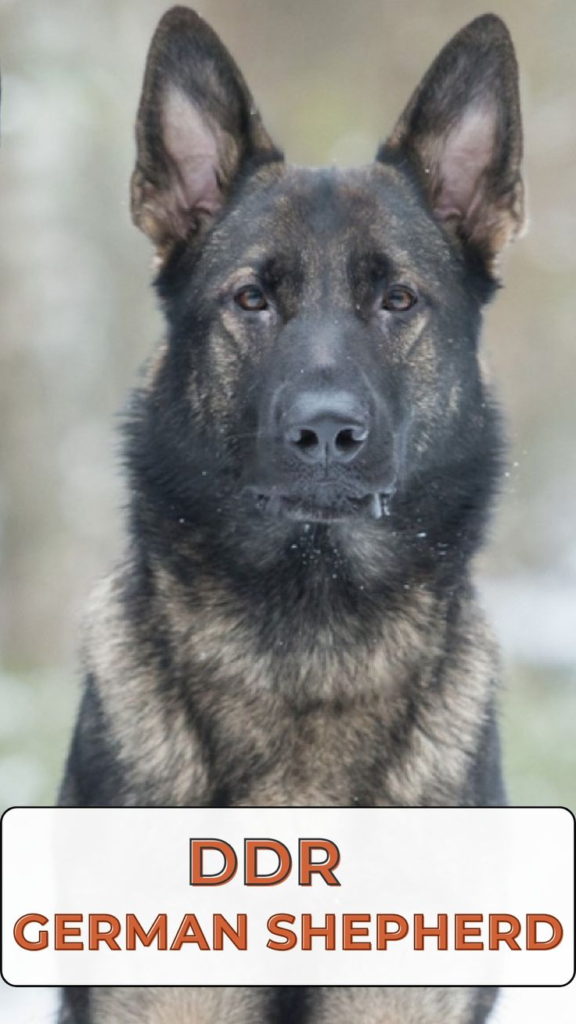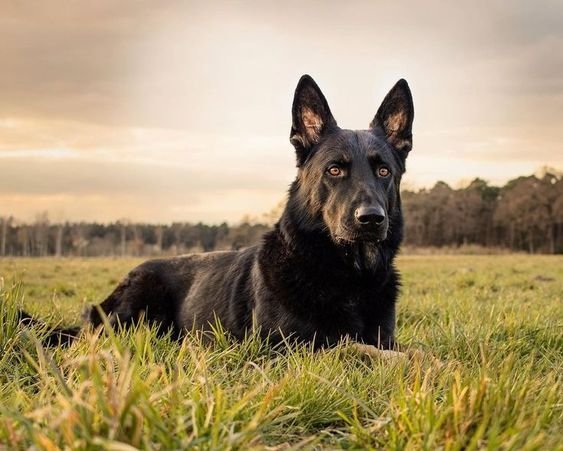Unveil the distinctive world of DDR German Shepherds, originating from the former East Germany. These canines embody a legacy of strength, intelligence, and unparalleled loyalty. Bred for exceptional working abilities, DDR German Shepherds offer a unique blend of robust physique and unwavering commitment.
Whether you’re seeking a devoted family guardian or a reliable working partner, these dogs bring a heritage of character to enhance your life. Explore the unparalleled qualities of DDR German Shepherds as you welcome a canine companion with a legacy like no other.
History
The DDR German Shepherd, also known as the East German Shepherd, has a unique history intertwined with the geopolitical changes in Europe, particularly in Germany during the mid-20th century. Here’s a brief overview of the background of this breed:
Origin in East Germany (DDR)
After World War II, the DDR German Shepherd breed was developed in the Deutsche Demokratische Republik (DDR), or East Germany. The East German government strictly controlled the breeding program.
Breeding and Characteristics
Unlike the West German Shepherds, DDR German Shepherds were bred for functionality rather than appearance. They were selected for their muscular, athletic build, intelligence, and working ability. These dogs are known for their straight back instead of the sloped back seen in other German Shepherd lines.

Use as Border Patrol Dogs
One of the most notable roles of the DDR German Shepherd was as a patrol dog along the Berlin Wall and the inner German border. They were trained to detect human scent and deter any attempts to cross the border.
Post-Reunification
After the fall of the Berlin Wall and the reunification of Germany in 1990, the strict breeding program of the DDR German Shepherds ended. However, the breed had already garnered a significant following.
Legacy and Modern Times
Today, the DDR German Shepherd is sought after for its unique characteristics and is often used in various types of service, including police and military work. They are also popular as family pets, known for their loyalty and protective nature.
About MK Haus DDR German Shepherds
MK Haus DDR German Shepherds is a breeding program specializing in maintaining and promoting the pure lineage of DDR (Deutsche Demokratische Republik) German Shepherds. This program stands out due to several critical aspects of its approach:
Focus on Pure DDR Lines
The core of MK Haus’s breeding philosophy is preserving pure DDR lines. This means they prioritize breeding German Shepherds that are descendants of the original dogs from East Germany. These lines have distinct characteristics, including robust health, strong bone structure, and excellent working abilities.
Mental and Physical Stimulation for Puppies
Recognizing the importance of early development, MK Haus strongly emphasizes providing mental and physical stimulation for their puppies. This approach ensures that the puppies are well-rounded, adaptable, and ready for various roles, whether in working environments or as family pets. Activities include exposure to different environments, puzzle-solving games, and age-appropriate physical challenges to promote growth and learning.
Selective Breeding Practices
When choosing sires and dams, MK Haus pays close attention to structure, temperament, and workability. This selective breeding process ensures that each litter maintains the desired traits of the DDR German Shepherd line. The structure is crucial for health and longevity, temperament is vital for a dog’s ability to work and interact with humans, and workability reflects the dog’s natural drive and ability to perform tasks.
Health and Temperament Testing
To maintain the high quality of their breeding lines, MK Haus likely conducts thorough health and temperament testing on their breeding dogs. This could include genetic screening, hip and elbow evaluations, and behavioral assessments to ensure their dogs are physically and mentally stable.
Commitment to the Breed’s Legacy
MK Haus’s breeding program is driven by a commitment to preserving the legacy of the DDR German Shepherd. This includes educating new owners about the breed’s history and characteristics and providing guidance on how to best care for and train these unique dogs.
DDR Studs
In a breeding program like MK Haus, focused on DDR German Shepherds, the male dogs, or studs, play a crucial role. While I don’t have specific information on individual dogs within their program, I can provide a general overview of what profiles of DDR studs typically entail:

Pedigree and Lineage
A DDR stud’s profile would feature his lineage, tracing back to original East German lines. This pedigree is crucial, as it ensures the preservation of the unique DDR characteristics. The pedigree would likely include information about his ancestors, including notable dogs in his lineage that exemplify the DDR breed’s qualities.
Physical Characteristics
Detailed descriptions of the student’s physical attributes will be included. This would encompass his size, weight, color (typically dark ebony, black, or black and tan), coat type, and distinctive DDR features like a straight back, sizeable, blocky head, and robust bone structure.
Health Clearances:
Health is paramount in breeding programs. Profiles for DDR studs would list clearances for common genetic issues in German Shepherds, such as hip and elbow dysplasia, degenerative myelopathy, and other breed-specific health tests.
Temperament and Behavior:
A vital aspect of a stud’s profile would be his temperament. DDR German Shepherds are known for their stable temperament, intelligence, and working ability. Information about the dog’s behavior, trainability, and working titles or certifications would be highlighted.
Contribution to the Breed
The profile might also discuss how the stud contributes to the DDR German Shepherd breed as a whole, focusing on how his specific traits and qualities are beneficial in maintaining the integrity and desired characteristics of the breed.
Photographs and Videos
Visual documentation is essential. Profiles typically feature photographs showing the stud’s physique and stance and videos demonstrating his working ability, temperament, and movement.
Offspring
Profiles of DDR studs are designed to provide a comprehensive view of the dog, showcasing not just his physical attributes but also his health, temperament, and abilities, ensuring that he is a perfect fit for maintaining and enhancing the DDR German Shepherd lineage.
DDR Females
In a DDR German Shepherd breeding program like MK Haus, the female dogs, commonly called dams, are integral to maintaining and enhancing the breed’s qualities. While specific details about individual dams in their program might not be available, a general overview of what information on DDR females usually includes can be outlined:
Pedigree and Lineage
Like the studs, the dams’ pedigree is of utmost importance. Their lineage is meticulously recorded to preserve the DDR German Shepherd’s unique characteristics. This includes information about their ancestors and any notable dogs in their family tree.
Physical Characteristics
Detailed descriptions of each dam’s physical attributes are crucial. This encompasses size, weight, coat color and type, and distinctive DDR features such as a straight back and robust build. This information helps understand how these traits may be passed on to their offspring.
Health Clearances
Health is a top priority in breeding. Dams undergo various health screenings to ensure they are free from genetic diseases common in German Shepherds, such as hip and elbow dysplasia and other breed-specific health issues.
Temperament and Behavior
The temperament of the dams is a critical factor in breeding. DDR German Shepherds are known for their stable, intelligent, and calm demeanor. Information about the dam’s behavior, adaptability, and training achievements will be highlighted.

Working Ability and Achievements
Many DDR German Shepherds are involved in work or sports. The dams’ profiles include tracking, protection, obedience, or service work accomplishments. This not only showcases their abilities but also indicates the potential qualities of their puppies.
Breeding History and Offspring
For dams that have been part of previous breeding cycles, information about their litters, including the health and achievements of their offspring, can be crucial. This helps understand the dam’s impact on the breed and the quality of puppies she produces.
Photographs and Videos
Visuals are essential for a complete profile. Photographs showcasing the dam’s physique, coat, and overall appearance, along with videos demonstrating their movement and temperament, are typically included.

Contribution to the Breed
The profile may also discuss how the dam contributes to the overall quality and legacy of the DDR German Shepherd breed. This includes how her specific traits and characteristics are beneficial for preserving the breed’s standards.
Contact
If you’re interested in DDR German Shepherds and are considering a dog from a breeder like MK Haus, located in Pontiac, Illinois, reaching out to them is straightforward. They provide various contact options to make inquiries easy and convenient. Typically, a contact page includes an email address and a phone number, allowing you to choose the best method. Additionally, many breeders offer an online contact form on their website, where you can fill in your details and your query. This form is a quick way to get in touch, especially if you’re seeking specific information about available puppies, adult dogs, or general questions about the breed.
FAQs
What is a German Shepherd of the DDR line?
When delving into the DDR German Shepherd, it’s essential to understand its roots in the Deutsches Demokratische Republik German Shepherd. This breed, originating from the German Democratic Republic, has a unique lineage tied to the socialist state of Eastern Germany since 1949. Often referred to as East GSD, these dogs are a product of their environment and a symbol of a historical era.
What is a fair price for a purebred German Shepherd?
Determining a fair price for a German Shepherd involves considering multiple factors. The average cost hovers around $2500, but price variation is expected, influenced by the dog’s age, breeder reputation, and unique traits like coat color. A typical German shepherd puppy may reach up to $3500, reflecting the careful breeding and quality assurance from reputable DDR breeders.
What is the best breed of German Shepherd?
Identifying the best breed of German Shepherd often leads experts to Landheim, renowned breeders and importers with a legacy spanning the past 40 years. Their commitment to excellence has earned them a reputation as one of the world’s best in DDR German Shepherd breeding.
How much do German Shepherds cost without papers?
The price can be significantly less when considering a German Shepherd without papers. While health-tested parents often cost between $1,500-$3,000, puppies from lines without such testing can be cheaper, sometimes as low as $200. However, remember, this often omits health and temperament testing.
What is the most expensive dog in the world?
The title of the most expensive dog sold goes to Big Splash, a red Tibetan Mastiff, fetching a staggering $1.5 million. This highlights the high prices in the world of expensive breeds, where costs range from $3,000 to $10,000 or more, despite their vast size and intimidating appearance.
Conclusion:
In closing, the decision to welcome a DDR German Shepherd into your life is a commitment to unparalleled companionship and canine excellence. Originating from a rich legacy, these remarkable dogs offer more than just loyalty; they bring a piece of history to your home.
With their robust physique, sharp intellect, and unwavering devotion, DDR German Shepherds are unique guardians and steadfast friends. As you embark on this personal journey with a breed rooted in strength and heritage, may the presence of a DDR German Shepherd enrich your life with the extraordinary qualities that make them truly one-of-a-kind.
